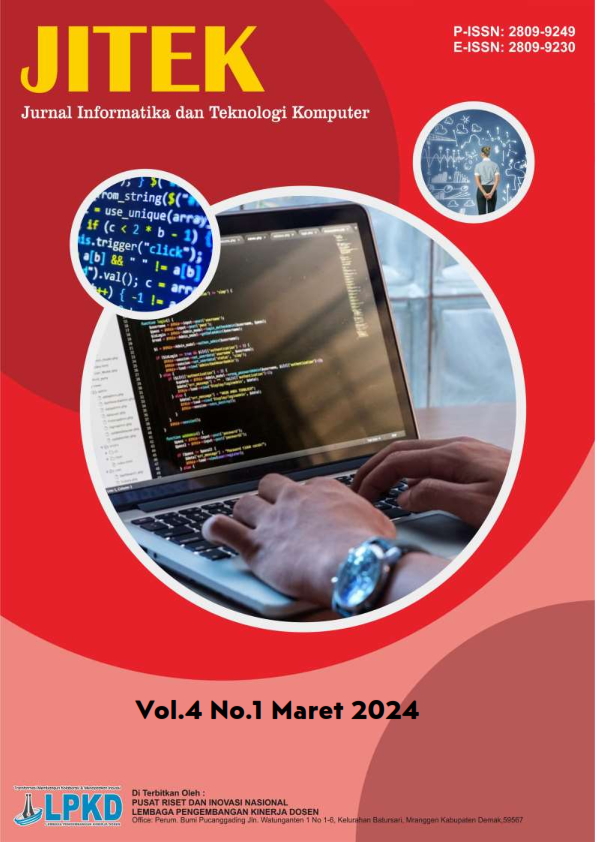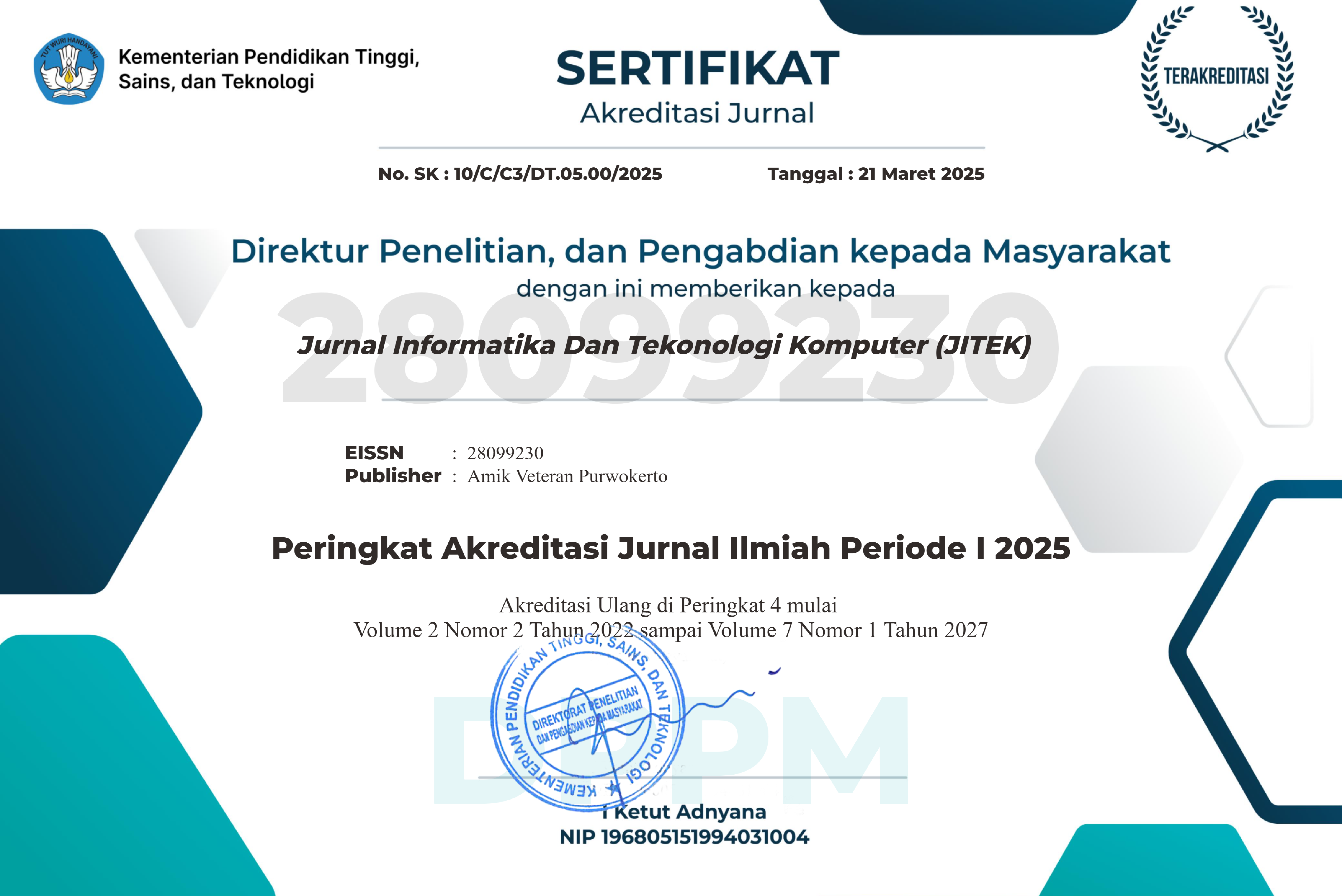Perbandingan Letensi antara Jaringan Berbasis Fiber Optik dan Wireless pada Lingkungan Perkotaan
DOI:
https://doi.org/10.55606/jitek.v5i1.6112Keywords:
letensi, fiber optik, wireless, perkotaan, perbandinganAbstract
This research aims to analyze and compare the liveness between fiber optic and wireless based networks in an urban environment. Letency or data transmission delay time is an important indicator in assessing network performance, especially in applications that require high speed and stability such as video conferencing, streaming, and other real-time services. With a qualitative descriptive approach and a little experimentation, measurements were made using ping and traceroute methods in three different types of locations, namely dense residential areas, offices, and public spaces. Results show that fiber optic networks consistently have lower average latency, stability, and minimal fluctuation compared to wireless networks such as Wi-Fi, 4G, and 5G. Wireless shows advantages in flexibility but disadvantages in terms of signal stability, which is strongly influenced by user density and environmental conditions. User perception supports this data, with the majority of fiber network users satisfied with the speed and stability of the connection. In conclusion, optical fiber is technically superior, but synergy with wireless technology is needed to support mobility and broad access. Future research is recommended to involve more network parameters and analyze hybrid network scenarios.
References
[1] S. Khan et al., “A Survey on X.509 Public-Key Infrastructure, Certificate Revocation, and Their Modern Implementation on Blockchain and Ledger Technologies,” IEEE Commun. Surv. Tutorials, vol. 25, no. 4, pp. 2529–2568, 2023, doi: 10.1109/COMST.2023.3323640.
[2] M. Van Den Ende, I. Lior, J. P. Ampuero, A. Sladen, A. Ferrari, and C. Richard, “A Self-Supervised Deep Learning Approach for Blind Denoising and Waveform Coherence Enhancement in Distributed Acoustic Sensing Data,” IEEE Trans. Neural Networks Learn. Syst., vol. 34, no. 7, pp. 3371–3384, 2023, doi: 10.1109/TNNLS.2021.3132832.
[3] V. K. Papanikolaou et al., “Simultaneous Lightwave Information and Power Transfer in 6G Networks,” IEEE Commun. Mag., vol. 62, no. 3, pp. 16–22, 2024, doi: 10.1109/MCOM.002.2300290.
[4] S. J. Ben Yoo et al., “Quantum Wrapper Networking,” IEEE Commun. Mag., vol. 62, no. 3, pp. 76–81, 2024, doi: 10.1109/MCOM.001.2300067.
[5] C. D. Wang et al., “Cross-Subject Tinnitus Diagnosis Based on Multi-Band EEG Contrastive Representation Learning,” IEEE J. Biomed. Heal. Informatics, vol. 27, no. 7, pp. 3187–3197, 2023, doi: 10.1109/JBHI.2023.3264521.
[6] H. Jiang, S. Shi, S. Zhang, J. Zheng, and Q. Li, “SLInterpreter: An Exploratory and Iterative Human-AI Collaborative System for GNN-based Synthetic Lethal Prediction,” IEEE Trans. Vis. Comput. Graph., vol. 31, no. 1, pp. 919–929, 2024, doi: 10.1109/TVCG.2024.3456325.
[7] Y. Wang, C. Wang, B. Zhu, G. Liu, E. Wang, and L. Guo, “Secure Three-Dimensional Guidance for Target Strikes Under Unknown Direction Attacks and Multiple Constraints,” IEEE Trans. Aerosp. Electron. Syst., 2025, doi: 10.1109/TAES.2025.3532252.
[8] X. Hu et al., “Multiple Heterogeneous Networks Representation with Latent Space for Synthetic Lethality Prediction,” IEEE Trans. Nanobioscience, vol. 23, no. 4, pp. 564–571, 2024, doi: 10.1109/TNB.2024.3444922.
[9] P. Borylo et al., “Neural Networks in Selected Aspects of Communications and Networking,” IEEE Access, vol. 12, pp. 132856–132890, 2024, doi: 10.1109/ACCESS.2024.3404866.
[10] M. Hashemi et al., “Principles and Operation of Virtual Brain Twins,” IEEE Rev. Biomed. Eng., 2025, doi: 10.1109/RBME.2025.3562951.
[11] X. H. Zhou et al., “Learning Skill Characteristics From Manipulations,” IEEE Trans. Neural Networks Learn. Syst., vol. 34, no. 12, pp. 9727–9741, 2023, doi: 10.1109/TNNLS.2022.3160159.
[12] S. Ruan et al., “Filling Delivery Time Automatically Based on Couriers’ Trajectories,” IEEE Trans. Knowl. Data Eng., vol. 35, no. 2, pp. 1528–1540, 2023, doi: 10.1109/TKDE.2021.3100116.
[13] W. Li, B. Wang, Z. H. Khattak, and X. Deng, “Network-Level Traffic Signal Cooperation: A Higher-Order Conflict Graph Approach,” IEEE Trans. Intell. Transp. Syst., vol. 24, no. 1, pp. 990–999, 2023, doi: 10.1109/TITS.2022.3191290.
[14] D. Townend, R. Husbands, S. D. Walker, and A. Sutton, “Challenges and Opportunities in Wireless Fronthaul,” IEEE Access, vol. 11, pp. 106607–106619, 2023, doi: 10.1109/ACCESS.2023.3319073.
[15] Y. Liu et al., “Rapid Edge-computing for Intelligent Fiber-Optic DAS,” IEEE Sens. J., 2025, doi: 10.1109/JSEN.2025.3554221.
[16] J. Zhou et al., “A programmable high-precision real-time optical beamforming network based on Galois Field,” IEEE Photonics Technol. Lett., vol. 37, no. 9, pp. 520–523, 2025, doi: 10.1109/LPT.2025.3554773.
[17] B. L. Pugliese et al., “Development of a Wearable Sleeve-Based System Combining Polymer Optical Fiber Sensors and an LSTM Network for Estimating Knee Kinematics,” IEEE Trans. Neural Syst. Rehabil. Eng., vol. 33, pp. 728–738, 2025, doi: 10.1109/TNSRE.2025.3540708.
[18] Q. Li, H. Wen, J. Yang, Q. Xu, X. Yang, and Y. Li, “All-Optical Regeneration and Format Conversion for 4APSK Signals Based on Nonlinear Effects in HNLF,” IEEE Photonics J., vol. 15, no. 1, 2023, doi: 10.1109/JPHOT.2023.3235905.
[19] A. C. Marceddu et al., “Air-To-Ground Transmission and Near Real-Time Visualization of FBG Sensor Data via Cloud Database,” IEEE Sens. J., vol. 23, no. 2, pp. 1613–1622, 2023, doi: 10.1109/JSEN.2022.3227463.
[20] T. Zeng, Q. Li, H. Li, D. Zhang, and M. Jiang, “China Telecom’s Research and Applications of Business-Enterprise Full-Optical Networking,” IEEE Access, vol. 11, pp. 55824–55833, 2023, doi: 10.1109/ACCESS.2023.3239882.
[21] J. Li et al., “Plastic-Optical-Fiber-Enabled Smart Glove for Machine-Learning-Based Gesture Recognition,” IEEE Trans. Ind. Electron., vol. 71, no. 4, pp. 4252–4261, 2024, doi: 10.1109/TIE.2023.3277119.
[22] J. Gomez, C. J. Hellin, A. Valledor, M. Barranquero, J. J. Cuadrado-Gallego, and A. Tayebi, “Design and Implementation of an Innovative High-Performance Radio Propagation Simulation Tool,” IEEE Access, vol. 11, pp. 94069–94080, 2023, doi: 10.1109/ACCESS.2023.3310825.
[23] F. Rawshan, M. Hossen, and M. R. Islam, “Multi-OLT Multi-Lane PON for 5G Fronthaul and Differential Services Through Access Class Priority-Based 2D Scheduling,” IEEE Open J. Commun. Soc., vol. 5, pp. 6593–6610, 2024, doi: 10.1109/OJCOMS.2024.3479241.
[24] P. Capitao, P. Pinho, and N. B. Carvalho, “Reconfigurable IoT Solution for Train Integrity and Monitoring,” IEEE Internet Things J., vol. 11, no. 12, pp. 22257–22268, 2024, doi: 10.1109/JIOT.2024.3379863.
[25] A. V. Savkin, C. Huang, and W. Ni, “Joint Multi-UAV Path Planning and LoS Communication for Mobile-Edge Computing in IoT Networks With RISs,” IEEE Internet Things J., vol. 10, no. 3, pp. 2720–2727, 2023, doi: 10.1109/JIOT.2022.3215255.
[26] M. Al-Quraan et al., “Edge-Native Intelligence for 6G Communications Driven by Federated Learning: A Survey of Trends and Challenges,” IEEE Trans. Emerg. Top. Comput. Intell., vol. 7, no. 3, pp. 957–979, 2023, doi: 10.1109/TETCI.2023.3251404.
[27] W. Wu, X. Wang, A. Hawbani, P. Liu, L. Zhao, and A. Al-Dubai, “FLORA: Fuzzy Based Load-Balanced Opportunistic Routing for Asynchronous Duty-Cycled WSNs,” IEEE Trans. Mob. Comput., vol. 22, no. 1, pp. 253–268, 2023, doi: 10.1109/TMC.2021.3074739.
[28] K. L. Bober, A. Ebmeyer, F. Dressler, R. Freund, and V. Jungnickel, “LiFi for Industry 4.0: Main Features, Implementation and Initial Testing of IEEE Std 802.15.13,” IEEE Open J. Veh. Technol., vol. 5, pp. 1625–1636, 2024, doi: 10.1109/OJVT.2024.3481884.
[29] D. Mishra et al., “Quantum-Safe Secure and Authorized Communication Protocol for Internet of Drones,” IEEE Trans. Veh. Technol., vol. 72, no. 12, pp. 16499–16507, 2023, doi: 10.1109/TVT.2023.3292169.
[30] S. Ozer, H. E. Ilhan, M. A. Ozkanoglu, and H. A. Cirpan, “Offloading Deep Learning Powered Vision Tasks from UAV to 5G Edge Server with Denoising,” IEEE Trans. Veh. Technol., vol. 72, no. 6, pp. 8035–8048, 2023, doi: 10.1109/TVT.2023.3243529.
[31] M. Nance-Hall, Z. Liu, V. Sekar, and R. Durairajan, “Analyzing the Benefits of Optical Topology Programming for Mitigating Link-Flood DDoS Attacks,” IEEE Trans. Dependable Secur. Comput., vol. 22, no. 1, pp. 146–163, 2024, doi: 10.1109/TDSC.2024.3391188.
[32] X. Liu, Y. Deng, and T. Mahmoodi, “Wireless Distributed Learning: A New Hybrid Split and Federated Learning Approach,” IEEE Trans. Wirel. Commun., vol. 22, no. 4, pp. 2650–2665, 2023, doi: 10.1109/TWC.2022.3213411.
[33] D. Shehada, A. Turky, W. Khan, B. Khan, and A. Hussain, “A Lightweight Facial Emotion Recognition System Using Partial Transfer Learning for Visually Impaired People,” IEEE Access, vol. 11, pp. 36961–36969, 2023, doi: 10.1109/ACCESS.2023.3264268.
[34] L. Zhu, M. M. Karim, K. Sharif, C. Xu, and F. Li, “Traffic Flow Optimization for UAVs in Multi-Layer Information-Centric Software-Defined FANET,” IEEE Trans. Veh. Technol., vol. 72, no. 2, pp. 2453–2467, 2023, doi: 10.1109/TVT.2022.3213040.
[35] G. Thakur, S. Prajapat, P. Kumar, A. K. Das, and S. Shetty, “An Efficient Lightweight Provably Secure Authentication Protocol for Patient Monitoring Using Wireless Medical Sensor Networks,” IEEE Access, vol. 11, pp. 114662–114679, 2023, doi: 10.1109/ACCESS.2023.3325130.
[36] X. Liang et al., “Advancing Human-Computer Interaction: Smartphone-Integrated POF Speckle Sensor for Gesture and Identity Recognition,” IEEE Sens. J., vol. 24, no. 19, pp. 30028–30037, 2024, doi: 10.1109/JSEN.2024.3437763.
[37] S. Nanataki, O. Koyama, K. Narumiya, K. Ikeda, and M. Yamada, “Expansion of Measurement Range of Low-Cost Ethernet-Based Temperature Sensing System Using Long-Period Fiber Grating,” IEEE Sensors Lett., vol. 8, no. 1, 2024, doi: 10.1109/LSENS.2023.3344105.
[38] S. Arifin, N. P. Dewi, . U., M. N. Arifin, and F. P. E. Putra, “Aplikasi Pengolahan Data Mahasiswa Kkn Pada Universitas Madura,” Insa. Comtech Inf. Sci. Comput. Technol. J., vol. 8, no. 2, p. 24, 2023, doi: 10.53712/jic.v8i2.2085.
[39] F. Prasetyo Eka Putra, Moh Riski, Riyan, Yayu Rahma Febriani, and Muhammad Umar Mansyur, “Optimization Of Web Based Academic Information System Design To Increase Efficiency In Junior High Schools,” J. Inf. dan Teknol., pp. 150–158, 2024, doi: 10.60083/jidt.v6i2.545.
[40] F. P. E. Putra, F. Fauzan, S. Syirofi, M. Mursidi, D. Wahid, and A. Nuraini, “Sistem Pengendali Lingkungan Pertanian Dengan Wireless Sensor Network Untuk Mengoptimalkan Budidaya Hidroponik,” 2024. doi: 10.47709/digitech.v3i2.3461.
[41] F. Prasetyo Eka Putra, S. Mellyana Dewi, and A. Hamzah, “Jurnal Sistim Informasi dan Teknologi https://jsisfotek.org/index.php Privasi dan Keamanan Penerapan IoT Dalam Kehidupan Sehari-Hari : Tantangan dan Implikasi,” J. Sistim Inf. Dan …, vol. 5, no. 2, pp. 26–32, 2023, [Online]. Available: https://jsisfotek.org/index.php
[42] F. P. E. Putra, D. A. M. Putra, A. Firdaus, and A. Hamzah, “Analisis Kecepatan Dan Kinerja Jaringan 5G (generasi ke 5) Pada Wilayah Perkotaan,” INFORMATICS Educ. Prof. J. Informatics, vol. 8, no. 1, p. 47, 2023, doi: 10.51211/itbi.v8i1.2439.
[43] S. Wang et al., “Machine-Learning-Based Human Motion Recognition via Wearable Plastic-Fiber Sensing System,” IEEE Internet Things J., vol. 10, no. 20, pp. 17893–17904, 2023, doi: 10.1109/JIOT.2023.3277829.
[44] C. Guerra-Yanez et al., “The Throughput Bottleneck of Quantum-secure Communication Links: Analysis and Mitigation,” IEEE Trans. Commun., 2024, doi: 10.1109/TCOMM.2024.3394746.
[45] K. Mizutani et al., “Dynamic Full-Duplex Cellular System for Wide Area IoT Network Backbone,” IEEE Open J. Veh. Technol., vol. 5, pp. 1215–1229, 2024, doi: 10.1109/OJVT.2024.3450279.
[46] E. Shi et al., “RIS-Aided Cell-Free Massive MIMO Systems for 6G: Fundamentals, System Design, and Applications,” Proc. IEEE, vol. 112, no. 4, pp. 331–364, 2024, doi: 10.1109/JPROC.2024.3404491.
[47] X. Li et al., “Physical-Layer Authentication for Ambient Backscatter-Aided NOMA Symbiotic Systems,” IEEE Trans. Commun., vol. 71, no. 4, pp. 2288–2303, 2023, doi: 10.1109/TCOMM.2023.3245659.
[48] K. Zhu, Z. Wang, Q. L. Han, and G. Wei, “Distributed Set-Membership Fusion Filtering for Nonlinear 2-D Systems Over Sensor Networks: An Encoding-Decoding Scheme,” IEEE Trans. Cybern., vol. 53, no. 1, pp. 416–427, 2023, doi: 10.1109/TCYB.2021.3110587.
[49] A. Kaushik et al., “Integrated Sensing and Communications for IoT: Synergies with Key 6G Technology Enablers,” IEEE Internet Things Mag., vol. 7, no. 5, pp. 136–143, 2024, doi: 10.1109/IOTM.001.2400052.
[50] X. Wang and Y. Song, “Edge-Assisted IoMT-Based Smart-Home Monitoring System for the Elderly With Chronic Diseases,” IEEE Sensors Lett., vol. 7, no. 2, 2023, doi: 10.1109/LSENS.2023.3240670.
[51] F. Prasetyo, E. Putra, M. Riski, M. S. Yahya, and M. H. Ramadhan, “Mengenal Teknologi Jaringan Nirkabel Terbaru Teknologi 5G,” J. Sistim Inf. dan Teknol., vol. 5, no. 2, pp. 167–174, 2023, [Online]. Available: https://jsisfotek.org/index.php
[52] N. Haidar Hari, F. P. Eka Putra, U. Hasanah, S. R. Sutarsih, and Riyan, “Transformasi Jaringan Telekomunikasi dengan Teknologi 5G: Tantangan, Potensi, dan Implikasi,” J. Inf. dan Teknol., pp. 146–150, 2023, doi: 10.37034/jidt.v5i2.357.
[53] F. P. Eka Putra, F. Muslim, N. Hasanah, Holipah, R. Paradina, and R. Alim, “Analisis Komparasi Protokol Websocket dan MQTT Dalam Proses Push Notification,” J. Sistim Inf. dan Teknol., pp. 63–72, 2024, doi: 10.60083/jsisfotek.v5i4.325.
[54] A. Zulfikri, F. P. E. Putra, M. A. Huda, H. Hasbullah, M. Mahendra, and M. Surur, “Analisis Keamanan Jaringan Dari Serangan Malware Menggunakan Filtering Firewall Dengan Port Blocking,” 2023. doi: 10.47709/digitech.v3i2.3379.
.
Downloads
Published
How to Cite
Issue
Section
License
Copyright (c) 2025 Jurnal Informatika Dan Tekonologi Komputer (JITEK)

This work is licensed under a Creative Commons Attribution-ShareAlike 4.0 International License.








